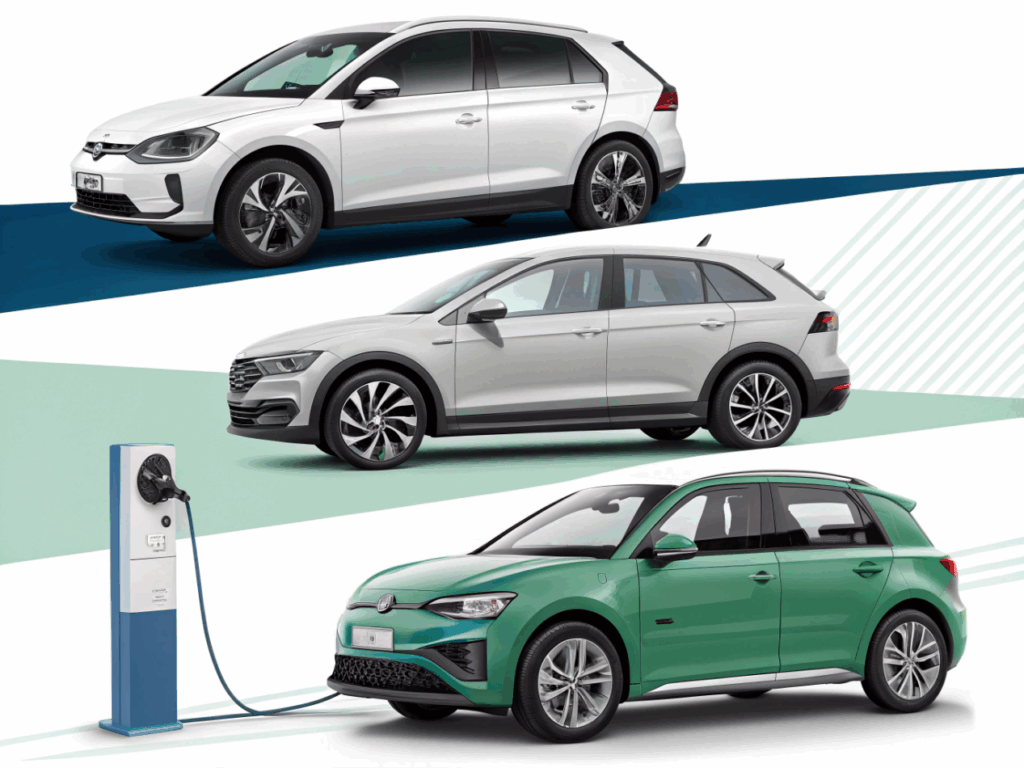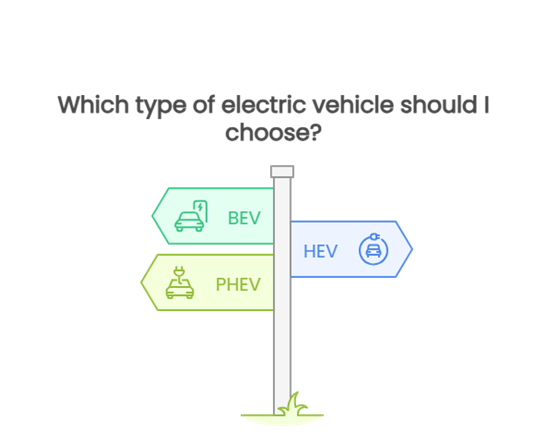BEV VS. HEV VS. PHEV: A Complete Guide to Different Types of Electric Vehicles
The electric vehicle revolution has arrived—but not all EVs are created equal. From pure-electric BEVs to self-charging HEVs and versatile PHEVs, each type offers distinct advantages depending on personal driving habits, budget, and environmental priorities.
To understand these options better, it’s important to explore the different types of electric vehicles today. This guide breaks down how these vehicles actually differ—in range, fueling, cost, and performance; stay tuned!

Battery Electric Vehicles (BEVs): Fully Electric Power
Definition
Battery Electric Vehicles, or BEVs, run entirely on electricity stored in large lithium-ion batteries. As one of the most emission-free types of electric vehicles, they don’t have traditional engines or exhaust systems—instead, they use electric motors to power the vehicle.
Operational Mechanics
In BEVs, electrical energy from the battery is converted into mechanical power by the electric motor. The absence of an ICE means a simpler drivetrain, with fewer components like transmissions and exhaust systems. Charging can be done via Level 1/2 AC chargers or fast DC chargers. Regenerative braking recovers energy during deceleration, enhancing the vehicle’s efficiency.
Hybrid Electric Vehicles (HEVs): Balancing Gas and Battery
Definition
Hybrid Electric Vehicles (HEVs) combine a gasoline-powered ICE with an electric motor and battery. Among the types of electric vehicles, HEVs are ideal for drivers seeking fuel efficiency without relying on charging infrastructure.
Energy Management and Efficiency
HEVs utilize a parallel hybrid system, meaning the gasoline engine and electric motor work together. At lower speeds or when idling, the electric motor takes over, providing a smooth and efficient ride. As the vehicle accelerates or faces heavier loads, the internal combustion engine kicks in.
Additionally, HEVs feature regenerative braking, which recaptures kinetic energy from braking and transforms it into electrical energy to replenish the battery.
Plug-in Hybrid Electric Vehicles (PHEVs): The Middle Ground
Definition
Plug-in Hybrid Electric Vehicles (PHEVs) combine the benefits of BEVs and HEVs. They feature larger batteries that can be charged externally, alongside an ICE to extend the vehicle’s range.
Charging and Flexibility
PHEVs offer charging options through standard outlets, Level 2 chargers, or regenerative braking. This flexibility allows drivers to choose between driving on electric power for short trips or using the ICE for longer journeys.
In electric mode, PHEVs are zero-emission vehicles, making them ideal for daily commuting. When the battery runs out, the gasoline engine activates, ensuring continuous mobility for extended trips.
Among all types of electric vehicles, PHEVs strike a practical balance for those who want electric efficiency without giving up gasoline flexibility.

BEV vs. HEV vs. PHEV: Which Should You Choose?
So, how to choose between BEV, HEV, and PHEV? Here are three main factors to consider:
1. Daily Driving Needs
Think about how far you typically drive each day.
If your daily mileage falls within the typical electric range—around 234 miles for most modern BEVs and 15–60+ miles for PHEVs—you may be able to rely mainly on electricity[1]. This can lead to lower fuel costs and fewer emissions.
For longer commutes or frequent road trips, a HEV or a long-range PHEV might be more practical, offering a balance of electric driving with gasoline backup for flexibility.
2. Charging Availability
Understanding your infrastructure will help narrow down the most suitable choice among the many types of electric vehicles. If you can charge at home—say, with a garage or driveway—BEVs and PHEVs become much more convenient.
For BEVs in particular, access to public charging stations is also important, especially for long trips. Cities with well-developed charging networks make owning a plug-in vehicle more appealing. If charging isn’t an option, HEVs are a good choice since they don’t need to be plugged in and recharged using regenerative braking.
3. Budget and Environmental Goals
Cost and environmental impact are also important.
BEVs generally have higher upfront prices but lower running costs and no tailpipe emissions. HEVs are typically more affordable and offer better fuel efficiency than regular gasoline cars. PHEVs fall in between—more expensive than HEVs but offering the potential for fuel savings and lower emissions if charged regularly and used mostly in electric mode.

Learn More at Mobility Tech Asia 2025
As you explore the distinctions between BEVs, HEVs, and PHEVs, there’s no better opportunity to deepen your understanding than by attending Mobility Tech Asia 2025.
The conference will host over 10 sessions led by more than 150 speakers, addressing critical topics such as cutting-edge technologies in e-boats and electric two-wheelers, EV/HV development, new energy storage systems, and hydrogen and fuel cell applications.
Whether you’re an industry professional, researcher, or enthusiast, MTA 2025 offers an unparalleled platform to connect, learn, and contribute to the evolution of electric mobility. To learn more about different types of electric vehicles, register now!
Reference
[1] Can I Make Long Distance Trips in an EV? Available at: https://mcecleanenergy.org/can-i-make-long-distance-trips-in-an-ev/ (Accessed: 29th, April)

